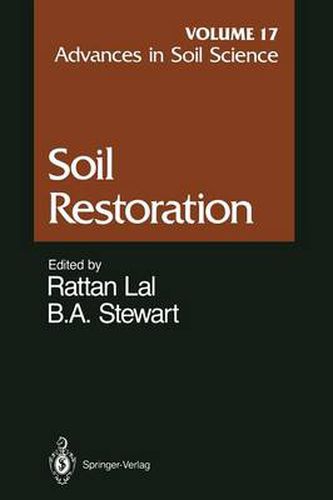Readings Newsletter
Become a Readings Member to make your shopping experience even easier.
Sign in or sign up for free!
You’re not far away from qualifying for FREE standard shipping within Australia
You’ve qualified for FREE standard shipping within Australia
The cart is loading…






This title is printed to order. This book may have been self-published. If so, we cannot guarantee the quality of the content. In the main most books will have gone through the editing process however some may not. We therefore suggest that you be aware of this before ordering this book. If in doubt check either the author or publisher’s details as we are unable to accept any returns unless they are faulty. Please contact us if you have any questions.
Soil degradation is clearly one of the most pressing problems facing man kind. A continuation of soil degradation will eventually lead to a loss in crop productivity even though fertilizers and other inputs often result in increased yields in the short term. Soil degradation also leads to environ mental pollution. A decrease in soil quality invariably leads to a decrease in water quality, and often in air quality. While there is a clear consensus that soil degradation is a major problem, the literature on this subject leaves numerous baffling questions. If statis tics on land degradation are correct, there is a definite cause for concern, and present a mammoth challenge for agricultural scientists. There are those that say the scientific community has over dramatized this issue, and created a credibility problem. Consequently; Volume 11 of Advances in Soil Science was organized by Dr. Rattan Lal who is recognized as a lead ing authority on the subject. The objective of Volume 11 was to assess the types and processes of soil degradation and establish some of the major cause-effect relationships. Volume II documented the seriousness of soil degradation in many parts of the world. Therefore, it seemed immediately important to devote a volume to the principles and technologies for restor ing degraded soils to a productive status. While the land resources are limited, world population is rapidly increasing, particularly in developing countries. Dr.
$9.00 standard shipping within Australia
FREE standard shipping within Australia for orders over $100.00
Express & International shipping calculated at checkout
Stock availability can be subject to change without notice. We recommend calling the shop or contacting our online team to check availability of low stock items. Please see our Shopping Online page for more details.
This title is printed to order. This book may have been self-published. If so, we cannot guarantee the quality of the content. In the main most books will have gone through the editing process however some may not. We therefore suggest that you be aware of this before ordering this book. If in doubt check either the author or publisher’s details as we are unable to accept any returns unless they are faulty. Please contact us if you have any questions.
Soil degradation is clearly one of the most pressing problems facing man kind. A continuation of soil degradation will eventually lead to a loss in crop productivity even though fertilizers and other inputs often result in increased yields in the short term. Soil degradation also leads to environ mental pollution. A decrease in soil quality invariably leads to a decrease in water quality, and often in air quality. While there is a clear consensus that soil degradation is a major problem, the literature on this subject leaves numerous baffling questions. If statis tics on land degradation are correct, there is a definite cause for concern, and present a mammoth challenge for agricultural scientists. There are those that say the scientific community has over dramatized this issue, and created a credibility problem. Consequently; Volume 11 of Advances in Soil Science was organized by Dr. Rattan Lal who is recognized as a lead ing authority on the subject. The objective of Volume 11 was to assess the types and processes of soil degradation and establish some of the major cause-effect relationships. Volume II documented the seriousness of soil degradation in many parts of the world. Therefore, it seemed immediately important to devote a volume to the principles and technologies for restor ing degraded soils to a productive status. While the land resources are limited, world population is rapidly increasing, particularly in developing countries. Dr.